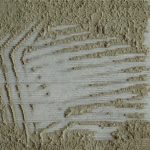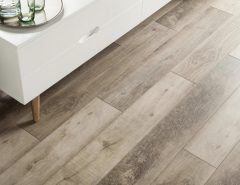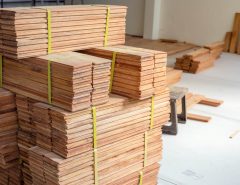What is laminate flooring underlayment? Why is it so important? What are some of the different types? Learn more here.
***
If you have engineered real wood flooring or laminate flooring, you will need laminate flooring underlayment. It is a free floating method of securing your floors, because the underlayment is actually not attached to the floor. Boards are secured to each other by joining the mating tongue and edges that have been grooved specifically for attachment. After joining all boards, the flooring underlayment is placed on top of the sub floor, and the main floor is assembled as the top layer.
Laminate flooring underlayment serves many purposes
a. It will deaden the sound when people are walking on the floor (this is why it is not attached)
b. It will make the floor feel softer when walking on it
c. It will absorb the slight structural edgings of the sub floor
There are four basic types laminate floor underlayment types from which to choose. Take a look at each of them to decide which variety works best for you.
1. Floor Muffler brand floor underlayment
Floor Muffler is a specialized brand of foam underlayment, complete with a moisture barrier. Professionals in the field swear by the brand, and it has served so well as an upgrade to regular foam underlayment that it deserves its own separate niche. Use Floor Muffler brand underlayment if you need to save money by not using cork underlayment, but you need the best solution for quiet sounding, safe floors which may experience more contact with moisture than would normal flooring.
Floor Muffler can be used with any free floating installation, including laminate. It is known as the best sound reducer on the market, covering up holes better than foam alone. It is also mold and mildew resistant, a must for places with moisture.
2. Solid cork underlayment
Solid cork floor underlayment is more expensive than foam, but provides better underlayment in general. Cork is porous, and so resists moisture quite well. Its texture also lends itself well to the sound muffling effect that underlaying is supposed to achieve. With laminate flooring, using cork underlayment will give the floor a hardwood feel, a distinguished effect. Cork is also a renewable resource, making it the most green of our choices.
Use cork with a moisture barrier for best effect. Cork can also be used for sub floor height, if you are so inclined. If there is a slight height increase between rooms, using cork as the flooring underlay can alleviate the problem with minimum of extra work.
3. Foam flooring underlayment
Foam is the most common and least expensive flooring underlayment. It achieves the least effect for sound muffling and comfort when walking. Foam is best used where moisture is unlikely to rise from the sub floor. If this is likely, moisture barriers can be installed with foam underlayment. Foam is most useful on the ground floors of buildings, because of its limited sound dampening capabilities.
4. Foam / film flooring underlayment
The foam and moisture protection built in is the cost effective version of cork, but it still gets the job done as an underlayment. If moisture is more of an issue and all you can use is foam, be sure to get the film combination to keep moisture from reaching the top layers of your flooring. Combination foam and film, however, does not help much with sound muffling.
Choosing laminate floor underlayment
It may seem like a small thing, but laminate flooring underlayment is a key element to a successful floor installation. It is an important ally to the health and stability of your floor. Choosing the right one for what you have in mind is therefore a pretty important step when embarking on a laminate floor project.
We hope the above makes things easier, and enjoy your new floors!





















